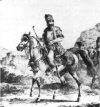|
INTRODUCTION
When
speaking of t h e Hedayat family in Iran,
people usually refer to the one Hedayat /
Kamal-Hedayat-family, that originates from Chahardeh Kalateh, part of
the former district of Hezar Jarib, between Damghan and the eastern
border of Mazandaran. It is
there, where the family
history starts with
the execution of the first traceable ancestor, Mohammed
Esmail
Beg by order of Zaki Khan Zand, in spring 1779.
I
The prominence of that
family is today largely due to Sadegh Hedayat, who is
considered to
be one of the most important authors of modern
Iranian
prose literature.
I
Yet, already
the great-grandfather of Sadegh, Mirza Reza Gholi Khan, known as 'Laleh Bashi',
with the pen-name 'Hedayat', has
founded the
high
reputation of that family, being not only considered one of the most learned men
of the
19th century Iran, but being an eminent author of many oeuvres on
(Qajar-)history and compilations on Iranian poets and poetry which are
frequently cited
up to this day.
I
Interestingly,
the close relation of the Hedayats to pen and paper is not
limited to above mentioned prominent members of the family. Jahangir
Hedayat and Sima Hedayat (nephew / niece of Sadegh H.) have published
own short stories, respectively poetry, not to talk about other members
that dispose about fascinating literary and poetical skills, but prefer
to present their oeuvres privately. Living and socialising in such an
environment, it is not surprising, that the Hedayats have family bonds
with
families of other prominent writers such as Ali Akbar Dehkhoda, Sadegh
Chubak and Bijan Jalali.
I
In politics
too, the Hedayats have left important marks, especially in the fields
of public
instruction and communication infrastructure of Iran. Mirza Reza Gholi Khan
Hedayat became
the
first
Vice-Director (Nazem) of the Dar-ol Fonun in 1852, which was Irans
first
Polytechnic. Hence,
both of his sons were educated at this college and rose to high senior
positions up to the top of the Ministry of Public Instruction, which
was headed
from 1881-1895 by the elder son, Ali
Gholi Khan Mokhber-ol Douleh I. and from
1895-1904 by
the younger son, Jafar Gholi Khan Nayer-ol Molk I., who previously had
been
Director of
the Dar-ol Fonun from
1861 to
1895.
|
The
Telegraph Affairs became the domain of the Senior Branch, which appears
in the
honorific title of Mokhber-ol Douleh
(= Reporter of the State),
which was
bestowed first in 1869/70 and held through three generations in this
family-branch - until the abolishment of all honorific and military
titles in
May 1925. Public
Instruction was almost the domain of the Junior
Branch, which
is reflected in the honorific title of Nayer-ol
Molk (= Light
of the
Country) that was from 1884/85 until 1925 held by two generations.
I
The first
Mokhber-ol Douleh, Ali Gholi Khan, was a highly respected man with an
outstanding integrity, mirrored in Iranian as well as in many foreign
sources. Thus he had considerable
influence at the court of Naser-ol Din Shah. Three of
Mokhber-ol Douleh's sons, privileged by birth, education and skills,
continued
to work and to strive for modernisation of Iranian politics.
I
"This family played a great role in the constitutional movement, especially the three
brothers Sani-ol
Douleh,
Mokhber-ol Saltaneh and
Mokhber-ol Molk, who lived in together in a large
house and
had
always
refused to take office during the days of tyranny" as E.G.
Browne has
stated it in his famous "The Persian Revolution".
I
As many other
families of the old aristocracy (i.e. those families in Iran, that had
been serving during several generations in high offices before
1925),
several family members have continued to serve the country under the
new dynasty of the Pahlavi as ministers and diplomats.
|
|
